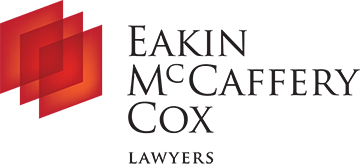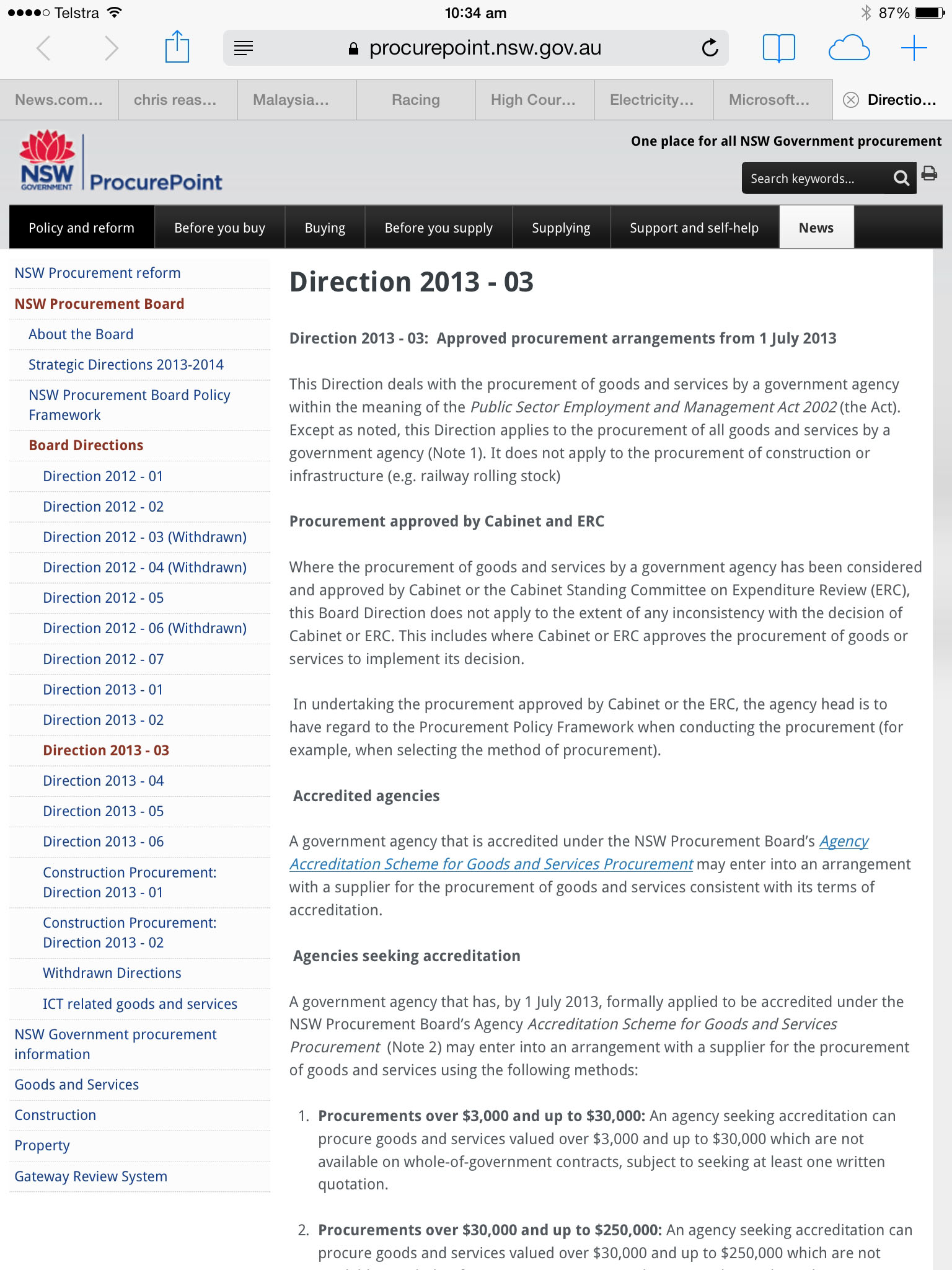Gregory Ross
Partner
Government Law Seminar
19 March 2014


Deciding when to outsource
When to outsource and what to outsource is, of course, an internal decision. It is partly a risk management decision. It is partly a resourcing decision.
There may well be policy reasons why some types of goods and/or services are not outsourced. For example, at both Commonwealth and New Wales Government levels, certain types of legal advice are, effectively, reserved to the Australian Government Solicitor and NSW Crown Solicitors Office.
To use the terminology of New South Wales, “core” legal issues are seen as ones which must be dealt with in a manner which not only involves appropriately experienced and knowledgeable lawyers but are recognised as ones requiring a degree of consistency of view, attitude and or policy.
The decision whether and when to outsource or not also involves a degree of provisioning skill.
The organization has to look inwards to itself to see what it is, what it needs, what it will need in the future and what, from time to time, it needs to be rid of.
Only then can management consider its procurement needs and how best to satisfy them.
By that I mean having appropriate systems, including needs analysis, in place to know the nature and extent of any given entity’s goods and services needs and how well it can or cannot satisfy those needs. That includes, for instance, knowing annual or seasonal peaks and troughs of internal demand and, where relevant, the extent to which that is dependent upon external demand.
It goes without having to be elaborated upon in any detail, but most government agencies now operate on scant budgets. It is no longer seen as appropriate for entities, particularly government entities, to have large stored inventories of the goods likely to be used in the next year or two.
Availability at demand with a short supply timeline, is, it would seem, more in vogue.
Obvious examples of reasons to justify outsourcing the provision of some goods and/or services include: –
- that it is cheaper and more cost efficient to obtain the relevant service externally, common examples include cleaning and maintenance services;
- that the agency or entity lacks the relevant expertise in-house, common examples include probity advice services, some forms of audit and advice services, legal advice and services;
- that existing internal resources cant cope and there is a need to deal with “overflow”;
- ensuring that goods and or services are being obtained / provided at a for value for money price;
- meeting some emergency need;
- that the relevant goods and / or services are not available under some existing Government panel contract or pre-approved contractor list.
I have heard arguments for and against some public health services such as “pathology services” being outsourced to one service provider. In context of major health centres, I would think a consistency of attitude and service of pathology service providers is to the advantage of the patient. Others may have a different view.
This paper does not deal, in any great detail, with the mechanisms appropriate for procurement of particular goods or services.
With most of today’s audience being lawyers, I will touch upon issues particularly relevant to the outsourcing of legal services because ever increasingly internal legal teams will be expected to outsource varying amounts of legal work.
Agencies of the Commonwealth must note the obligation (cl 7.7 of the Commonwealth Procurement Rules) to consider their procurement needs for the future and to the requirement for annual procurement plans to be prepared and published on its website.
Time constraints prevent any detailed examination of issues relating to infrastructure projects and or Information Technology Systems and services being considered today. They could easily each involve seminars of a whole day or more, but the underlying contract, process and probity issues remain much the same as those for the general contractual procurement of goods and services.
In Australia, Government Contracting is and always has been a specialised field. It has its own issues. In my view is becoming increasingly complex and field in which staff of government agencies, if not experienced in the field, should be very wary. Too often have I seen people involved in contract management who have never worked in a contracting related area,. This sometimes results in issues arising through a lack of experience, and very limited knowledge of the actual contract and the original terms agreed to.
Now, more than ever, those issues include the scrutiny to which public sector staff-involved in procurement are subject.
Government procurement and Government contracting ranges, of course, from buying everything from stationery for Government offices to procuring armed weapons, from public transport to water supplies.
Procurement reform has been in progress for some years and many steps have been taken in the last couple of years.
One of the most significant developments having implications for Public Sector staff is the devolution of responsibility for procurement which puts agency staff involved in that procurement more in the line of scrutiny for probity type reasons.
Accordingly, we are confronting a new regime in which staff in agencies, in the absence at a NSW level of the State Contracts Control Board (SCCB), are no longer shielded from allegations of a probity type in context of basic Government procurement.
This of course requires the Government to ensure that staff are properly trained in both what they are doing and why they are doing it.
From my observations, that training is often, too often, inadequate and/or inappropriately directed.
Since I initially became involved in Government contracting in the late 1980s, having advised NSW ICAC and been a member of its internal review committee, I can’t tell you how many of the allegations made in respect of misfeasance or malfeasance in Government procurement and contracting flow from staff not having been properly trained.
They might be trained in process, but, all too often, not in the reasons.
In short, my attitude to Government contracting is that the people involved in negotiating contracts, especially in the Public Sector, are more likely to move on than in the private sector.
Therefore, there is a real need to have a clear paper trail, before and after grant of contract, as well as being clear up front. The contract, however formal or informal, has to address clearly WHAT, WHO, WHEN, WHERE AND WHY of procurement and contracting.
In my observations this is a significant issue that Contractors face within Government Procurement.
In a number of projects I have seen involving Government the government party’s authorised representative changed multiple times through people leaving the Government agency, and each new representative, never completely understanding of the contract, let alone what was actually agreed upon during the initial negotiation stages and acceptance stages.
In my observations, operations under the new Government Procurement regimes do not seem, to me, to place adequate emphasis on this.
Contracts and drafting, particularly in a Government procurement context, are a dynamic area of legal and commercial issues. It is also, in my experience, one in which contract templates and processes must be seen as an exercise in continuous improvement and, unfortunately for the lawyers, constant frustration.
Indeed, in my view, the templates promulgated by the NSW Procurement Board might best be described as “works in progress”, for a number of reasons, some of which I mention later in this presentation. Not the least of those reasons is that in mid May 2013 a new version of the standard standing offer contract was published by the NSW government, which is consistent with the government policy which expressly states that documents will be reviewed from time to time.
Current legislation on Procurement Contracts
2014 is a relatively important year, so far as concerns legislation relevant to procurement arrangements due to both New South Wales and Commonwealth of Australia legislative changes to the background legislation relevant to procurement.
The coming into force in the middle of 2014 of the Public Governance, Performance and Accountability Act 2013 (PSPA Act) will effectively bring all Commonwealth entities under one umbrella piece of legislation.
In New South Wales the background legislation previously contained in the Public Sector Management and Employment Act 2010 has, with the abolition of that act consequent upon the passing of the Government Sector Employment Act caused the procurement provisions to be re-enacted as part of the Public Works and Procurement Act 2014 and the regulations under that act called the Public Works and Procurement Regulation 2014.
Interestingly, when I was refining this paper in late February 2014, I noticed that whilst the Public Works and Procurement Regulation 2014 was clearly available publicly the Public Works and Procurement Act 2014 was not yet available until some days later. Unusually, even the dates of publication suggested the Act was posted after the Regulation.
I proceeded upon the basis that the Public Works and Procurement Act 2014 must have been proclaimed before the Regulation but I did not choose to spend significant time and effort tracking down when it was proclaimed. That should appear on the relevant websites in due course.
At both New South Wales and Commonwealth levels the legislative provisions would appear to be part of the ongoing reform of procurement, which commenced some years ago, and continues and continues and continues and continues.
Whilst I do not doubt the desirability of ongoing reform I do have to wonder whether the manner in which it is being done is, particularly at the State level, is conducive to both public sector consumers and private sector suppliers being made adequately familiar with the changes and their implications on a regular basis.
Needless to say today’s paper is not going to deal in detail with each and every piece of legislation that Commonwealth and or State of New South Wales level dealing with procurement but only the major pieces of legislation.
I do not in this paper deal with specific entity legislation which may confer particular procurement empowerment provisions because, in my view, the manner in which both Commonwealth and State of New South Wales procurement arrangements are now subject to promulgated policy documents would appear to me to have an old effect. That is that, other than as background legislation. I suggest specific to agency empowering legislation would appear to be rendered significantly less important.
I have to say from a technical perspective I find that unusual that but that is how the world is presently working.
At both Commonwealth and New South Wales level the general legislation, in my view, only facilitates and/or empowers, with the more important practical implications and directives being dealt with in policy documents and practice directions.
Whilst in this paper I mentioned the facilitating and directive legislation relevant to procurement proper, not to be forgotten at Commonwealth and State of New South Wales levels is the plethora of legislation which can and does impact on operations under a contract. That includes law such as Freedom of Information and or Government Information Public Access, workplace, health and safety, privacy and others.
Privacy legislation, equal opportunity, workplace health and Safety and child protection legislation are also relevant across the board and can have particular significance in many procurement situations.
For example, in researching this paper I decided to look to determine the amount spent on Goods and services by Government. This, surprisingly, is not as easy as it used to be.
However, what I did find what this useful (not) piece from a government site on the Costs of Children http://www.aifs.gov.au/institute/pubs/costspm.html: –
“examines the difficulties of estimating the direct costs of children, arguing that the cost of a child is not an objective fact but varies according to tastes and preferences, and the amount of money parents have to spend on their children.”
Well, what a finding that is!
Some Problems in Practice
Apart from the background facilitating legislation I need to draw attention to some particular legislation which can have impact on a contract both in its formation and management stages.
Peekaboos — “PCBUs”
Recent legislation, particularly that to do with Work Health and Safety Act 2011 Cwth [see particularly sections 20 to 26], now places obligations much more on the person or persons in a position to “control” a workplace or particular aspects of it.
In the context of procurement contracts involving contractors coming on to a government site, contractors going onto a third party site and/or government staff going onto a contractor site, real issues of control and responsibility can and do arise.
The historical option of having a broad brush indemnity, such as that contained in some template contracts, is, in my view, no longer adequate.
Indeed, given the common Government template’s provisions allowing the relevant government agency to inspect premises of the supplier [and/or the reverse], I can imagine that in some circumstances inspection of those premises before grant of contract and from time to time, during the term of the contract, will need to be carried out.
The nature of obligations imposed on the person in a position to “control” a workplace under current legislation involves quasi-criminal liability.
There must be some real doubt as to whether the contractual indemnity will be adequately enforceable in respect of such liability let alone whether it is even worth considering, as an option to deal with the issue, purporting to “delegate responsibility” to a contractor.
Commonwealth
At the date of preparation and delivery of this paper the main Commonwealth legislation dealing with procurement comprises the Financial Management and Accountability Act 1997 and the Commonwealth Authorities and Companies Act 1997, the Financial Management and Accountability Regulations 1997 and the Commonwealth Authorities and Companies Regulations 1997.
Additionally, there are the Finance Minister’s Orders for Financial Reporting and the Finance Ministers’ (CAC Act Procurement) Directions 200 and Finance Circulars.
All of which operate, necessarily, against the background of the Commonwealth Constitution, the Public Service Act 1999, the Commonwealth Crimes Act 1914, the Auditor-General Act 1997, annual appropriation Acts, competition policy is, reporting policies and various international treaty obligations which are beyond the purview of today’s paper
However, both of the main pieces of legislation are to be replaced with effect from the middle of 2014, by the Public Governance, Performance and Accountability Act 2013 (PSPA Act) which consolidates the two pieces of legislation into one and moves from a strict compliance approach to a principles-based framework.
The PGPA Act is intended to effect “a cultural change in Commonwealth resource management from a compliance approach to financial management, to a principles-based framework. Commonwealth entities are encouraged to think differently about how they manage resources.” The legislation involves four key principles, that:
- “Government should operate as a coherent whole;
- A uniform set of duties should apply to all resources handled by Commonwealth entities;
- Performance of the public sector is more than financial; and
- Engaging with risk is a necessary step in improving performance.” To support the implementation of the PGPA Act:
- Rules and better practice guidance will be established to assist Commonwealth entities to manage resources; and
- All relevant Commonwealth legislation will be reviewed to identify necessary consequential amendments />, which will form the basis of a consequential amendments Bill to go to the Parliament.
PGPA Rules are being prepared. The PGPA Rules will specify financial management requirements for Commonwealth entities. They will deal with the issues previously dealt with under the Financial Management and Accountability Regulations 1997 and the Commonwealth Authorities and Companies regulations 1997.
The new PGPA Rules, consistently with the new legislation, are to better reflect a resource management cycle. That includes: –
- to undertake corporate planning;
- performance management reporting standards and annual performance statements to better emphasise improved reporting and evaluation of the operations of Commonwealth entities;
over time, an introduction of the idea of relative autonomy “under which Commonwealth entities will meet core obligations and additional requirements will be based on the level of performance and risk of an entity.”
Training and guidance material to assist Commonwealth staff in implementation of the new financial regime are being prepared and will be provided to Commonwealth entities and their staff. At the time of preparation of this paper (January 2014) the website of the Department of Finance did not contain links to any such material but flagged them as “coming soon early 2014”.
The public sector management reform process aims to modernise the financial framework of the Australian Government so that it will support high quality resource management and performance now, and into the future. Whilst no one can criticise that aim, time will tell how successfully the aim is satisfied by its implementation.
I extract the following from relevant Commonwealth websites: –
“The reform the financial framework commenced with the Commonwealth Financial Accountability Review (CFAR) in December 2010. During 2011-12, the Department of Finance and Deregulation released a series of issues papers to Commonwealth agencies to elicit discussion on financial management and performance. A Discussion Paper </about/discussion-paper/> was publicly released on 27 March 2012, which was accompanied by an extensive program of consultation. Feedback from stakeholders, including within government, with state and territory officials, the private sector and academia, was obtained and firmer propositions were put forward again in a Position Paper </about/position-paper/> on 23 November 2012.
On 16 May 2013 the Public Governance, Performance and Accountability Bill 2013 (PGPA Bill)
</legislation-pgpa-act/>, a Bill to consolidate Commonwealth financial framework legislation within a single Act, was introduced into the Parliament of Australia. Subsequently the Joint Committee of Public Accounts and Audit (JCPAA) conducted an inquiry into the PGPA Bill and tabled their report
http://www.aph.gov.au/parliamentary_business/committees/house_of_representatives_committees?url=jcpaa/accountability_bill/report.htm on 4 June 2013. The Public Governance, Performance and Accountability Act 2013 (PGPA Act) http://www.comlaw.gov.au/Series/C2013A00123 was passed by the Parliament on 28 June 2013 and received the Royal Assent on 29 June 2013.”
Unfortunately at the time of preparation of this paper, the draft rules available had nothing to do with relating to procurement
Beneath the various pieces of primary and secondary legislation sit a number of policy documents dealing with the substance of procurement operations frameworks.
They comprise: –
Commonwealth Procurement Rules (which made under the FMA Act but will need to be renewed under the new legislation though at the time of preparation of this paper I was unable to find any such provision having been made);
Finance Procurement Policy Website Finance Circulars
General Commonwealth Procurement guidance documents.
At the time of preparation of this paper I can only assume that the pre-existing exemption for indigenous Business enterprises from division two of the Commonwealth Procurement Rules is to continue under the new public sector management regime of the Commonwealth – details of the exemption existing as at the date of my preparation of this paper are available on the internet at https://www.finance.gov.au/sites/default/files/Indigenous%20exemption.pdf
When refining this paper in late February and early March I note that the Commonwealth provisions consequent upon passing the new Commonwealth legislation are still somewhat in a state of flux as to regulations guidelines and proposals so far as concerns status of the Commonwealth Procurement Rules.
As I understand the general intent, the existing Commonwealth Procurement Rules will continue to apply but not as regulations under the new legislation. There was a reference in one of the policy papers to concern that making the regulations would render some of the provisions of the Commonwealth Procurement Rules subject to disallowance by Parliament.
It was put that some of the content of the Commonwealth Procurement Rules flowed from international treaty obligations and that Government did not want them put at risk of disallowance.
So the short point is, it is all a work in progress.
New South Wales
- Public Works and Procurement Act 1912 which replaces the Public Sector Employment and Management Act 2010 (PSME Act) – mainly chapter 7
- Public Works and Procurement Regulation 2014 which replaces Public Sector Employment and Management Regulation 2009 Part 4A and Schedule 1 Competitive Neutrality
- Public Finance and Audit Act /Public Authorities (Financial Arrangements) Act
- Treasurers Directions (effectively having force under section 9 of the Public Finance and Audit Act)
Pursuant to the provisions of the PWP Act, the NSW Procurement Board was established. It replaces the previous State Contracts Control Board. Its functions have changed from being the main procurement agency to being more a overarching policy directive entity which has issued various policy documents and template documents.
The provisions of the Public Works and Procurement Regulation 2014 substantively continue by virtue of transitional provisions the policies and procedures set up by the pre-existing NSW Procurement Board (some of which are themselves a continuation of policies and all contracts put in place by the previous state contracts control board).
The main such document, drawn from the NSW Procurement Board website, is –
GOODS AND SERVICES – PROCUREMENT – POLICY FRAMEWORK – FOR NSW GOVERNMENT
AGENCIES Version 2 July 2013
There are many template documents relating to and ranging from needs analysis to terms and conditions, but this is not the time or place for consideration of them. As at 27 February 2014, that site made no reference to the new NSW legislation.
To a great extent, the situation remains, if there is a pre-approved provider or a panel or ‘piggyback” contract, it can be used.
However, I have to say I don’t find that site, particularly so far as concerns finding pre-approved or prequalified suppliers user friendly.
Comments to me from intending suppliers to Government and clients in Government are to much the same effect.
To me, it is a little strange that notwithstanding the passing of new legislation in New South Wales, as at the first week in March 2014, the NSW procurement website makes no reference to the legislative changes.
Due diligence ensuring compliance
Increasing at both Commonwealth and State of New South Wales level, agencies are obliged to report on their outsourcing arrangements and issues.
In the dim, dark days of last century, when I first became significantly involved in Government procurement, the system involved:
- the SCCB organising contracts for the “public service“, from which agencies could buy from at will;
- agency officers could do direct purchasing for goods and services under a relatively small threshold, some without quotes (for small value), some a number of quotes (some oral, some in writing) again dependent upon the value of the contract ;
- where quotes were required for goods above another threshold, the use of EOI or RFT for procurements of significant values unless there was an existing “period contract” relevant to particular goods or services which would be used by agencies.
The threshold concept remains under the document reforms, with obvious changes to the monetary limits in question.
The terms and conditions used by SCCB for general goods and services, when I first started acting for it, involved about four pages of close print which came to about 27 clauses.
It was good for me because, after advising on them for a short while, I could practically recite them, which was great for giving advice over the telephone in response to queries which came in from time to time (by which I mean time and time and time again).
I well remember guidelines relating to value of goods or services thresholds which determined whether a full tender, a number of quotes or straight purchase could be adopted. The new procurement policies update those thresholds.
The system applicable in the early 1990s involved a handful of policies to be borne in mind. They included New South Wales regional policy development, a reference for Australian textiles and the like.
Back then, when there was a dispute with a supplier about some aspect of the goods or services provided, one could normally negotiate a settlement arrangement, if for no other reason that most suppliers were disinclined to cut off the hand that fed them by forcing Government to terminate their appointment to whatever panel contract was in issue.
In the 21st century, contractors are more litigiously minded as well as being more minded to go to the media by way of complaint. The NSW Procurement reforms are, in part, to deal with that reality.
Intending contractors are also probably more inclined to make complaint to oversight authorities, such as the NSW Ombudsman and the Independent Commission Against Corruption of NSW.
Challenges to various tender processes, led to the Courts finding the “process contract’, and obligations concerning confidential information.
More and more government policies became relevant to the evaluation of tenders so complicating the process and warranting the recent reforms.
The Now
As I understand it from various NSW Government Annual reports, in the year 2010/2011 the NSW Government spent an estimated $12.7 billion on goods and services.
SCCB contracts for goods and services accounted for about $3.8 billion of that expenditure in that year.
Under the new procurement policies, we have the NSW Procurement Board, replacing SCCB, but with more an overview policy role than actual contract creation, though it does have a role in propounding templates for use by public sector agencies.
Where the NSW government has “whole of government” contracts in place, agencies should make use of them. The list of the contracts is available on the NSW Procure Point website.
This presentation will not address the issues relating to monetary limits for thresholds for various procurement methodologies, as they are freely available on the NSW Procurement Board website and will, of course, change over time.
The current web link to access relevant detail of current NSW process and templates is: http://www.procurepoint.nsw.gov.au/policy/goods-and-services/goods-and-services-policies/using-nsw-government-contracts.
As mentioned above, the most significant changes are that substantive procurement procedure is now delegated back to the agencies themselves and the practicalities of procurement in regional areas has been recognised for agencies in those areas.
With the aggregation of various agencies into “clusters”, it is envisaged that there will be some “piggybacking” arrangements under which other agencies in the broader NSW Government diaspora will be able to access contracts in particular goods and services categories which had their origins in creation for and by some major agency which has a much greater needs of particular goods or services in issue.
The concept under the new arrangements is that procuring agencies will make use of the most up-to-date template for the various procurement needs. That will involve developing this skill of being able to move between and select from the various templates well aware of their own needs and the requirements and content of each of the various templates offered. They include: –
- Easy Registration template situations and awareness of the operation of the Approved List and the Plain English Contract and Dictionary for the Approved List;
- the non-IT Standing Offer Agreement Template;
- the customer contract order arrangements – particularly services;
- tendering conditions in Statement of Requirements;
- Agency Specific Terms – non-IT;
- Request for Quote whether under State contract or not.
The delegation back to agencies of procurement task of course brings with it the obligation to maintain openness and transparency of process.
Not infrequently and particularly for large procurements government has long adopted the prudent practice of making use of probity auditors and/or probity advisors.
A little to my surprise, I have noticed an increasing propensity for both State and Federal agencies to make use of internal resources for probity advice/audit.
The very nature of probity advice/audit implies something of an external review of the particular processor subject of the advice/audit.
Whilst I can appreciate the cost savings of using internal resources for probity advice/audit, it does raise the real risk that some probity advice/audit might not be considered as sufficiently objective to satisfy the requirements of the market place.
Whether that role can or should be carried out by a department or agency legal team, to bolster the objectivity aspect, will, of course, depend on the availability of staff to do so.
I would have thought that another reason in favour of the use of lawyers for probity advice/audit is that, at least to some extent, much of their advice may well be privileged from disclosure. However, that will really depend on the detail of the operations of any internal legal team and the extent to which it can properly assert a degree of objectivity sufficient to attract legal professional privilege.
Outsourcing Services
For agencies which are in any way involved in outsourcing the provision of services historically provided by Government, not insignificant issues arise in context of the selection of the outsourcing contractors.
That includes not only the usual things to do with capacity, reputation experience, cost, responsiveness, reporting and the like.
The risk issues involved in that type of outsourcing would appear, to me, necessarily to include agencies having to have a slightly broader vision of a “chain of supply” of the relevant goods and services.
That includes consideration, as an exercise in risk management and determining the capacity of the intending contracted supplier, of how the contracted supplier itself supplies the staffing and goods and/or services required to provide the outsourced services.
It will also include how that contracted supplier stores personal information in respect of the end user. It is not simply a matter of technical compliance with relevant privacy legislation (whether general or the more specific medical privacy legislation) but also consideration of how and where that information is stored and government needing to be satisfied that the storage of that personal information is relevantly safe.
Issues can, of course, also arise in an FOI/GIPA context in that outsourcing situation.
Keeping up to Date
Needless to say, agencies which have not previously been much involved in the procurement process will have to think carefully about their systems for tracking contracts.
I have often, over the years, have had to advise agencies which, for one reason or another, had forgotten to replace contracts before they expired.
For lawyers at both State and Federal levels, increasing governance of procurement by regularly changing policies directives and the like is bound to involve a degree of frustration.
Keeping Procurement Under Control?
It seems trite to say that the ability of anyone to keep procurement under control very much depends on the size of the organisation in question and, more importantly, the resources being put into doing so.
Indeed, the very fact that smaller agencies are allowed to “piggyback” on the contracts of larger agencies somewhat complicates the issue.
I well appreciate that long-term unavailability of resources has led to a situation in which the current government moved to implement its policy of reform of the Procurement system.
Almost universally within Government, the internal legal teams of departments and agencies are under significant stress resource-wise and may often be unable adequately and properly to support their internal procurement teams as well as the NSW Procurement Reforms seem to envisage.
Legal teams will have to take great care clearly to identify their role so far as concerns procurement exercises undertaken by their employer department/agency. Responsibility to agencies (especially those which are comprised within a different legal entity) which “piggyback” on a main contract is problematic, at best.
One of the NSW Procurement Board templates talks in terms of the Government Principal being able to “novate” the contract to other government departments and agencies.
One can only hope that the use of the word “novate” was not intended to convey the meaning understood by lawyers which is clearly inappropriate to arrangements between government departments which are all themselves the one legal entity – the State of New South Wales.
Legal teams will have to clearly identify their role in the terms of engagement relating to the role so far as concerns procurement exercises undertaken by their employer department/agency.
That will include, I suggest:-
- clear specification of minimum notification and turnaround times. The last thing needed by an overstretched internal legal team is a request from the Procurement section of the department/agency giving 24 hours or less time to consider and advise on what will often involve very large contract documents with a considerable amount of support -explanation papers;
- finding time to settle agency templates well before they are needed;
- recommending apt process to deal with the Workplace safety issues mentioned above;
- clear specification of the need to give consideration to the liability cap provisions in the standard documents;
- acceptance, almost as due diligence exercise, but in light of new workplace safety legislation, that there is a need to consider all aspects of the location of the performance of the services as relevant to who is in control for the purposes of that legislation and “PCBU” issues rather than, as may historically have been the norm, simply to rely on broad-brush indemnities which do not now adequately deal with the situation;
- consideration whether proper “milestones” and/or “performance criteria” have been identified and adequately provided for in the contract documents;
- finding time to settle agency arrangements to apply where the particular agency is to be the lead agency in respect of which other agencies can “piggyback”, consistently with the new Procurement Policy, when the “lead agency” may not be particularly familiar with the requirements of “piggybacking” smaller agencies; and
- development of agency specific risk management profiles and how they link to the relevant provisions of the approved templates.
Risk Management: What Can the Lawyers Do?
The new NSW regime envisages the NSW Procurement Board having an overarching role in respect of terms and conditions but I doubt it has the resources properly to carry out such a role.
Even if Government consistently sets template provisions, the old problem which will arise will be as to the extent to which agencies, exercising the procurement function themselves, will properly and adequately appreciate the commercial, risk, probity in process and legal reasoning behind some of the terms and conditions set by the responsible (State or Federal) agencies..
In my observations, often the procurement section of agency, for one reason or another, seeks to operate independently of the Legal Services section of agency. Far be it from me to suggest that some procurement staff see lawyers as generally obstructive, though I have heard it said.
That may make it very difficult for Legal Services sections to have meaningful input into and/or maintenance of approved templates, but Legal Services sections will have to work closely with relevant procurement staff on lines of responsibility.
Too often have I seen, both in public sector and private sector, the benefits of good templates being wasted by people working, not from the base template but from a contract recently used by somebody they work with who said was a good one for that type of deal.
An earlier document may well have been very appropriate for the earlier deal, but if and to the extent that it departed, for one reason or another, from the provisions of the standard template, alas, too often, the reasons for doing so in the reasons for particular provisions will not be apparent. I doubt Procurement Sections will have resources adequate to compare the terms of the “recent” agreement with the template to allow staff to determine what has been removed or added and what the reasons were for doing so.
Hence, staff should work from the base template but, alas I fear they too often will not be able to do so. Those base templates will themselves need, from time to time updating and review.
Where a Procurement Section wants advice from the Legal Services section or some approval from Legal Services section, it is an absolute imperative that a proper timeframe be set in place to enable lawyers to give meaningful and useful advice.
Similarly and where at all possible, I would recommend that Legal Services sections of agencies become involved in the training of procurement staff and the settling (and long-term review from time to time) of relevant agency specific refinements to template precedents.
When I refer to training, I mean not simply the basics of the contract process that the probity and processor rules relevant to procurement in the public sector.
As mentioned earlier in the paper, an internal legal team may well be able to offer assistance in the context of probity advice/audit and, in doing so, provide aspects of the probity advice/audit with legal professional privilege.
Thank you
Greg Ross | Partner
Eakin McCaffery Cox
Level 28, 1 Market Street Sydney NSW 2000
PO Box Q1196 QVB NSW 1230; DX 1069 Sydney
t: (02) 9265 3070 f: (02) 9261 5918
m: 0413 544 106 w: www.eakin.com.au

The views and comments expressed in this paper are those of the writer and not Eakin McCaffery Cox and are of general comment only. The comments are not to be taken as advice on any particular scenario or situation..
The writer acknowledges the assistance and or contribution of the following in the preparation of this paper:
Alexander Ware – Paralegal Eakin McCaffery Cox





